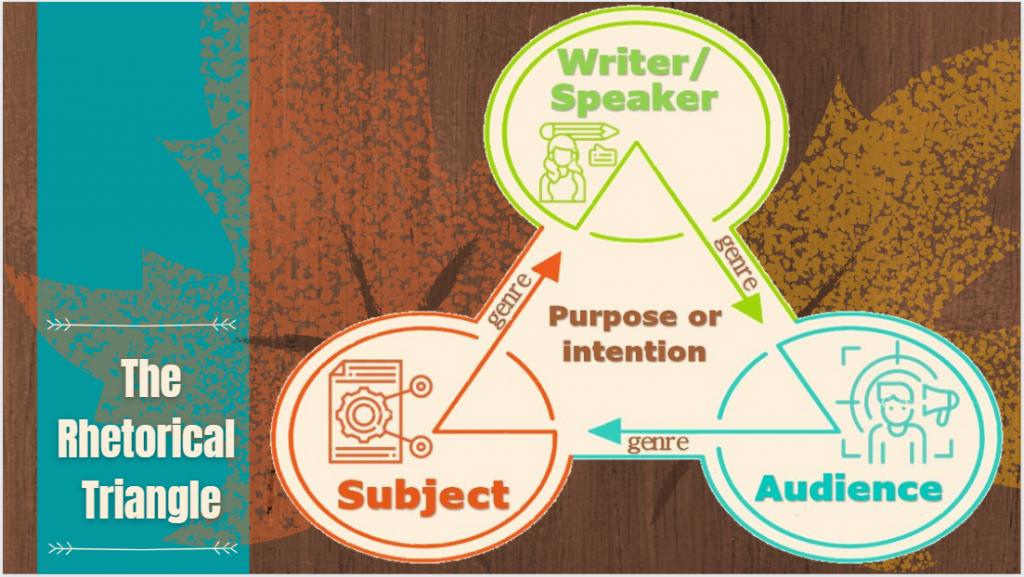3.3 The Basics: The Rhetorical Triangle as Communication Formula
Erin Kelly; Sara Humphreys; Nancy Ami; and Natalie Boldt
There are many elements that make up any communication situation, some of which have come up in the previous two chapters. In Section 2.2 Genres, Stories, and Academic Writing we discussed conventions as repeated acts of communication in a specific rhetorical situation (and we explained why that’s important). In this chapter, we are going to move beyond the conventions of communication forms (such as emails and essays) and dive into the elemental aspects of communication. Did you know any act of communication (even this one!) is shaped by three key factors? Here they are:
The subject of your communication: The subject matter you are writing or speaking about always affects your communication. Some subjects need longer discussions, and others require only brief consideration. Some seem important and worthy of investigation, and others might require certain forms of language or design to drum up interest. (This government initiative to warn about vaping uses slick graphics, for example.) And a writer or speaker might appear to have the authority to address some subjects more than others. Effective communication is built around thoughtfully chosen subject matter.[1]
The audience you are addressing: How you discuss a subject depends on the audience of readers or listeners being addressed. Those familiar with a subject won’t need as much background information. Those who basically agree with your key points won’t require as much explanation or supporting evidence. Audiences can be swayed by their sense of who is presenting the subject matter. Effective communication takes the intended audience into consideration. We pay special attention to the concept of audience in this chapter because, for most undergraduate students in Canada, this concept is unfamiliar.
The author or speaker (that’s you): Sometimes the person presenting subject matter to an audience has personal experience related to that topic. Perhaps you are writing an essay about skateboarding as an Olympic sport and you skateboard. You can probably share an anecdote about learning to skateboard that would build your credibility on the subject matter as a person with experience. Sometimes a writer or speaker is well-known by the audience and would seem trustworthy discussing almost any topic. For example, Dr. Roberta Bondar is a well-respected Canadian scientist and astronaut who is often asked to share her wisdom. Sometimes a writer or speaker expresses themselves in a way that makes the audience feel skeptical about whether the writer is sufficiently informed. In all cases, the speaker or writer plays an important role in effective communication.
You can already see how the above elements of communication are interrelated. For this reason, these elements are often represented as a triangle (see Figure 3.1), but not just any type of triangle.

The writer/speaker, the subject matter, and the audience are mapped onto an equilateral triangle aptly called the rhetorical triangle to show that each of these elements are inextricably interrelated as well as illustrate that they operate best when in balance with each other (more on this in Section 3.5 Everything’s Persuasion). This communication formula emerges from ancient Greek philosopher Aristotle’s treatise on rhetoric, and it still can help anyone who wants to communicate effectively.[2]
In each and every act of communication, the elements of the rhetorical triangle are in play. This textbook, though, is not about each and every act of communication, but is meant to help you be the best academic writer you can be. Therefore, the next three sections explicitly explore the audience for academic writing, because this aspect of the rhetorical triangle can be tricky.
- “Consider the Consequences of Vaping,” Government of Canada, October 18, 2022, https://www.canada.ca/en/services/health/campaigns/vaping.html. ↵
- If you’d like to read Aristotle’s treatise in full, you can check your university library for a copy of Rhetoric or read W. Rhys Roberts’ translation available online through the Internet Classics Archive: classics.mit.edu/Aristotle/rhetoric.html. You’ll find the material on which the rhetorical triangle is based under “Part 2” of Book I. ↵

